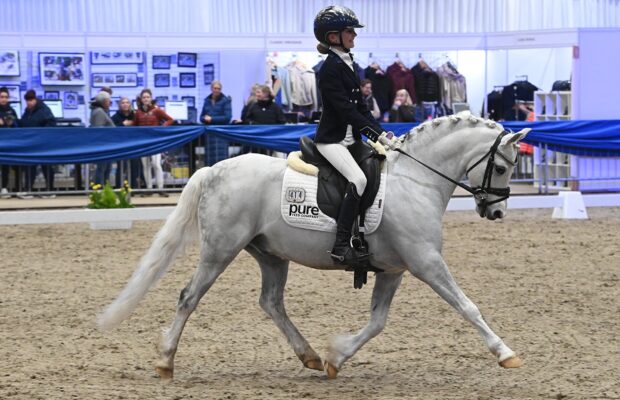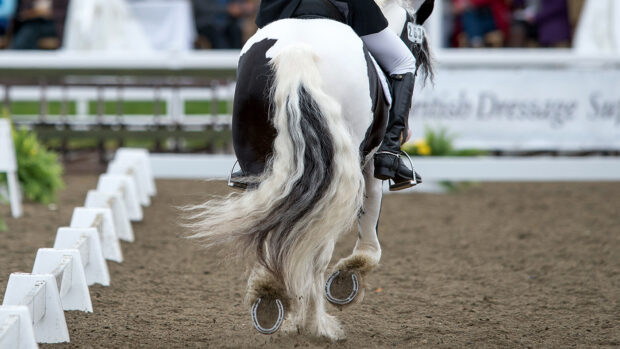“I don’t care what breed they are,” stated international dressage judge Stephen Clarke. “Dressage is about judging horses against the criteria — I don’t care how big, or what colour they are.
“There is only one horse in recent times who only has highlights and no real weaknesses — Valegro. He can fulfil almost all the criteria which is why he’s broken records, but it’s a rarity. Some horses find the collection work easy, while some find it easier to extend, but its very rare to find a horse who can go to the extremes of both.”
Stephen demonstrated his belief in this notion with an enlightening masterclass that featured a wide variety of breeds and types of horse.
Welsh section D

Martin Greet presented the Welsh section D mare Watling Shakira.
Although the mare is no stranger to competition — competing at medium level — she started tense in the atmosphere of the Hartpury arena, and her trot was hurried and choppy.
“She’s a bit quick at the moment, but that’s the mind as much as the body,” Stephen told Martin. “Play with the transitions and ride the lateral work to start if the horse is nervous — it often gives them something else to think about.”
Stephen asked Martin to ride numerous walk-trot transitions alternating with shoulder-in steps.
“Do that until the horse ‘gives its self up’ and relaxes into the work,” Stephen advised. “The safer and more secure the rhythm becomes, the more you can think about riding forwards to encourage ground cover and improve the quality of the trot.”
The mare — a compact, responsive type — was hot and reactive.
“She’s sharp today, but I like this automatic sharpness,” said Stephen. “Later on, when her training is more established, that will pay dividends as you’ll know you’ll always get a reaction from her.”
Stephen encouraged Martin to ride lots of small changes of pace within the trot.
“Take time and make small variations in the bend and speed to relax her,” he suggested.
It worked wonders. By the end of their session, Shakira’s trot had slowed and she was showing a rounder, more elevated stride. She was relaxed over her back, allowing her to make larger steps, and her increased confidence meant she was no longer hurrying.
To finish, Martin stretched her neck down.
“When the horse stretches in trot, allow time for the horse to spring up onto the next diagonal pair with big strides so they can engage the back muscles and swing into a contact,” Stephen concluded.
Lusitano

With Jade Clark on the grey advanced medium Lusitano stallion Espirito, Stephen worked more on the basic trot.
“He has a lovely natural regularity in his paces and a correct natural frame,” praised Stephen.
After riding some more collected trot, Stephen asked Jade to lengthen the strides across the diagonal. Espirito was so willing to please that he flew across the school and, although his energy was wonderful, he pushed himself off the hindleg and onto the forehand.
Stephen had an exercise to fix it. Jade rode a short period of shoulder-in on the long side, then straightened and asked for some medium strides before putting Espirito back into shoulder-in for the final part of the long side. The effect was immediate.
“The quality of the medium trot is all about the level of engagement in the working trot,” explained Stephen, “so the horse can keep pushing without falling on to his forehand. For the higher marks, the engagement and uphill balance is key.”
Continued below…
Like this? You might also enjoy reading these:
At last weekend's British Dressage national convention (19-20 November), Ferdi Eilberg began by focusing on the fundamental dressage building blocks
Stephen Clarke on being talent-spotted by Harvey Smith, judging record-breaking tests and being proud to be British

Ferdi Eilberg: don’t be too greedy with a talented horse

All in a day’s work: International dressage judge Stephen Clarke *H&H Plus*

Subscribe to Horse & Hound magazine today – and enjoy unlimited website access all year round
Gypsy cob

When Charlie Samuel-Camps first asked her gypsy cob gelding Glasshards Warrior for some extended trot strides, she didn’t get much of a reaction.
“Don’t think for a moment that just because he’s a cob he hasn’t got lengthening,” chided Stephen. “It just about training his reactions.”
Stephen asked Charlie to give Glasshards Warrior a flick with her schooling whip as she asked, but that meant she also pulled back with the rein. To correct this Stephen had her ride the lengthened strides with her reins in one hand and use the whip with her other, free hand (pictured) so as not to interfere with the contact.
The resulting burst of energy from the attractive horse resulted in a round of applause.
“It’s amazing how we can unlock the horse’s potential when there’s a genuine reaction to be had,” said Stephen. “Don’t let him fool you; there’s a lot in there. Sometimes you just have to take a risk.
“In a judging situation, I feel we can be generous to riders for minor mistakes. It’s all about trying to encourage riders to take a risk and ask for a reaction that will lead to a future of good work.”
Stephen Clarke was talking at the 2016 British Dressage national convention (19-20 November)



